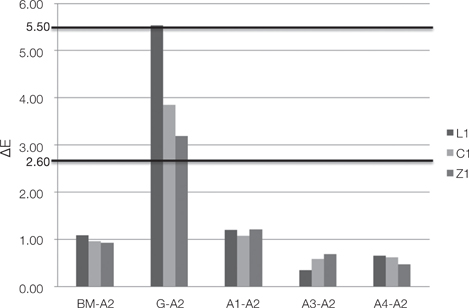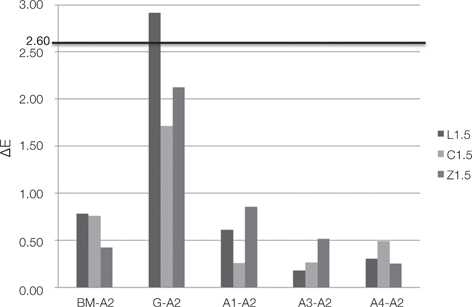J Adv Prosthodont.
2015 Oct;7(5):368-374. 10.4047/jap.2015.7.5.368.
Effect of abutment shade, ceramic thickness, and coping type on the final shade of zirconia all-ceramic restorations: in vitro study of color masking ability
- Affiliations
-
- 1Department of Prosthodontics, Graduate School of Clinical Dental Science, The Catholic University of Korea, Seoul, Republic of Korea.
- 2Department of Prosthodontics, Samsung Medical Center, College of Medicine, Sungkyunkwan University, Seoul, Republic of Korea. seokgyu_k@hanmail.net
- KMID: 2083879
- DOI: http://doi.org/10.4047/jap.2015.7.5.368
Abstract
- PURPOSE
The aim of the study was to evaluate the effect of abutment shade, ceramic thickness, and coping type on the final shade of zirconia all-ceramic restorations.
MATERIALS AND METHODS
Three different types of disk-shaped zirconia coping specimens (Lava, Cercon, Zirkonzahn: o10 mm x 0.4 mm) were fabricated and veneered with IPS e.max Press Ceram (shade A2), for total thicknesses of 1 and 1.5 mm. A total of sixty zirconia restoration specimens were divided into six groups based on their coping types and thicknesses. The abutment specimens (o10 mm x 7 mm) were prepared with gold alloy, base metal (nickel-chromium) alloy, and four different shades (A1, A2, A3, A4) of composite resins. The average L*, a*, b* values of the zirconia specimens on the six abutment specimens were measured with a dental colorimeter, and the statistical significance in the effects of three variables was analyzed by using repeated measures analysis of variance (alpha=.05).The average shade difference (DeltaE) values of the zirconia specimens between the A2 composite resin abutment and other abutments were also evaluated.
RESULTS
The effects of zirconia specimen thickness (P<.001), abutment shade (P<.001), and type of zirconia copings (P<.003) on the final shade of the zirconia restorations were significant. The average DeltaE value of Lava specimens (1 mm) between the A2 composite resin and gold alloy abutments was higher (close to the acceptability threshold of 5.5 DeltaE) than th ose between the A2 composite resin and other abutments.
CONCLUSION
This in-vitro study demonstrated that abutment shade, ceramic thickness, and coping type affected the resulting shade of zirconia restorations.
Keyword
Figure
Reference
-
1. Piconi C, Maccauro G. Zirconia as a ceramic biomaterial. Biomaterials. 1999; 20:1–25.2. Ozkurt Z, Kazazoglu E, Unal A. In vitro evaluation of shear bond strength of veneering ceramics to zirconia. Dent Mater J. 2010; 29:138–146.3. Kelly JR, Nishimura I, Campbell SD. Ceramics in dentistry: historical roots and current perspectives. J Prosthet Dent. 1996; 75:18–32.4. Uludag B, Usumez A, Sahin V, Eser K, Ercoban E. The effect of ceramic thickness and number of firings on the color of ceramic systems: an in vitro study. J Prosthet Dent. 2007; 97:25–31.5. Shokry TE, Shen C, Elhosary MM, Elkhodary AM. Effect of core and veneer thicknesses on the color parameters of two all-ceramic systems. J Prosthet Dent. 2006; 95:124–129.6. Antonson SA1, Anusavice KJ. Contrast ratio of veneering and core ceramics as a function of thickness. Int J Prosthodont. 2001; 14:316–320.7. Heffernan MJ, Aquilino SA, Diaz-Arnold AM, Haselton DR, Stanford CM, Vargas MA. Relative translucency of six all-ceramic systems. Part I: core materials. J Prosthet Dent. 2002; 88:4–9.8. Heffernan MJ, Aquilino SA, Diaz-Arnold AM, Haselton DR, Stanford CM, Vargas MA. Relative translucency of six all-ceramic systems. Part II: core and veneer materials. J Prosthet Dent. 2002; 88:10–15.9. Wang F, Takahashi H, Iwasaki N. Translucency of dental ceramics with different thicknesses. J Prosthet Dent. 2013; 110:14–20.10. Spyropoulou PE, Giroux EC, Razzoog ME, Duff RE. Translucency of shaded zirconia core material. J Prosthet Dent. 2011; 105:304–307.11. Baldissara P, Llukacej A, Ciocca L, Valandro FL, Scotti R. Translucency of zirconia copings made with different CAD/CAM systems. J Prosthet Dent. 2010; 104:6–12.12. Luo XP, Zhang L. Effect of veneering techniques on color and translucency of Y-TZP. J Prosthodont. 2010; 19:465–470.13. Lim HN, Yu B, Lee YK. Spectroradiometric and spectrophotometric translucency of ceramic materials. J Prosthet Dent. 2010; 104:239–246.14. Pecho OE, Ghinea R, Ionescu AM, Cardona Jde L, Paravina RD, Pérez Mdel M. Color and translucency of zirconia ceramics, human dentine and bovine dentine. J Dent. 2012; 40:e34–e40.15. Barizon KT, Bergeron C, Vargas MA, Qian F, Cobb DS, Gratton DG, Geraldeli S. Ceramic materials for porcelain veneers. Part I: Correlation between translucency parameters and contrast ratio. J Prosthet Dent. 2013; 110:397–401.16. Spink LS, Rungruanganut P, Megremis S, Kelly JR. Comparison of an absolute and surrogate measure of relative translucency in dental ceramics. Dent Mater. 2013; 29:702–707.17. Chaiyabutr Y, Kois JC, Lebeau D, Nunokawa G. Effect of abutment tooth color, cement color, and ceramic thickness on the resulting optical color of a CAD/CAM glass-ceramic lithium disilicate-reinforced crown. J Prosthet Dent. 2011; 105:83–90.18. Ali AAB, Kang K, Finkelman MD, Zandparsa R, Hirayama H. The effect of variations in translucency and background on color differences in CAD/CAM lithium disilicate glass ceramics. J Prosthodont. 2014; 23:213–220.19. Charisis D, Koutayas SO, Kamposiora P, Doukoudakis A. Spectrophotometric evaluation of the influence of different backgrounds on the color of glass-infiltrated ceramic veneers. Eur J Esthet Dent. 2006; 1:142–156.20. Douglas RD, Brewer JD. Acceptability of shade differences in metal ceramic crowns. J Prosthet Dent. 1998; 79:254–260.21. Ragain JC Jr, Johnston WM. Color acceptance of direct dental restorative materials by human observers. Color Res Appl. 2000; 25:278–285.22. Douglas RD, Steinhauer TJ, Wee AG. Intraoral determination of the tolerance of dentists for perceptibility and acceptability of shade mismatch. J Prosthet Dent. 2007; 97:200–208.23. Ruyter IE, Nilner K, Moller B. Color stability of dental composite resin materials for crown and bridge veneers. Dent Mater. 1987; 3:246–251.24. Shimada K, Nakazawa M, Kakehashi Y, Matsumura H. Influence of abutment materials on the resultant color of heat-pressed lithium disilicate ceramics. Dent Mater J. 2006; 25:20–25.25. Azer SS, Ayash GM, Johnston WM, Khalil MF, Rosenstiel SF. Effect of esthetic core shades on the final color of IPS Empress all-ceramic crowns. J Prosthet Dent. 2006; 96:397–401.26. Dozić A, Kleverlaan CJ, Meegdes M, van der Zel J, Feilzer AJ. The influence of porcelain layer thickness on the final shade of ceramic restorations. J Prosthet Dent. 2003; 90:563–570.27. Crispin BJ, Okamoto SK, Globe H. Effect of porcelain crown substructures on visually perceivable value. J Prosthet Dent. 1991; 66:209–212.28. Seghi RR, Hewlett ER, Kim J. Visual and instrumental colorimetric assessments of small color differences on translucent dental porcelain. J Dent Res. 1989; 68:1760–1764.29. Johnston WM, Kao EC. Assessment of appearance match by visual observation and clinical colorimetry. J Dent Res. 1989; 68:819–822.30. Bolt RA, Bosch JJ, Coops JC. Influence of window size in small-window colour measurement, particularly of teeth. Phys Med Biol. 1994; 39:1133–1142.31. Johnston WM, Hesse NS, Davis BK, Seghi RR. Analysis of edge-losses in reflectance measurements of pigmented maxillofacial elastomer. J Dent Res. 1996; 75:752–760.
- Full Text Links
- Actions
-
Cited
- CITED
-
- Close
- Share
- Similar articles
-
- The influence of porcelain layer thickness and color on the final shade of ceramic restorations
- Influence of several posts and IPS-Empress ingot thickness on the final shade of all-ceramic crowns
- Spectrophotometric analysis of the influence to shade of zirconia core on the color of ceramic
- Spectrophotometric analysis of the influence of zirconia core on the color of ceramic
- Influencing factors on the final color of laminate veneer restorations with various IPS Empress Esthetic(R) ingots







